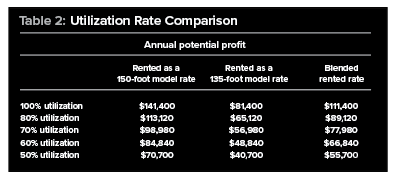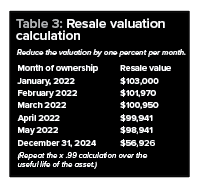Business Management -- How to calculate return on investment
When purchasing construction equipment, perform the proper calculations to ensure that it’s a smart purchase.
by Ben Preston
Purchasing construction equipment, especially high-ticket items, can be an unsettling process. There are few resources like those available for cars and homes to know what is considered a good price before purcahsing.
 |
 |
 |
Having the assurance that an equipment purchase will generate net positive cash flows within a year or two makes a five or six-figure price an easier pill to swallow.
The following example breaks down how to calculate the return on investment (ROI) of a 2014 150-foot boom lift listed at $103,000 on Gearflow (www.gearflow.com), a web site that address the productivity problems found in the construction industry .
This methodology is not an exact science but it offer a good estimate of the ROI of a machine prior to purchasing. For even more conservative estimates, additional costs for parts and servicing expenses can be included.
This kind of analysis is highly recommended to help with purchase price negotiation as well as ease any hesitation when adding a new or used piece of equipment to a rental fleet.
1. Determine depreciation cycle
As soon as a rental center acquires or decides on purchasing a piece of construction equipment, whether used or new, it begins to depreciate. Depreciation is the reduction in the value of the asset over time. In this example, we know that the average useful rental life of a 150-foot boom lift, if properly maintained, is around 12 years.
Given that this is a 2020 model, there are about 5 years left of rental value left, therefore making the depreciation cycle 5 years or 60 months.
This means that we will get a depreciation value of $1,716 per month by dividing the sale price ($103,000) by the remaining useful life (60 months).
2. Identify the retail rental rate
Based on experience, this machine rents for about $13,500 per month. For a more data-informed approach to set rental rates, data companies such as EquipmentWatch can be useful. This leaves a profit of $11,783.33 (rental rate – monthly depreciation) if it achieves 100 percent utilization. However, 100 percent utilization is impossible, so that gets adjusted in step 4.
3. Calculate blended retail rate
To achieve high utilization rates, rental centers won’t always be renting the equipment for its maximum working height or capacity.
The 150-foot boom lift in this example can also be rented as a 135-foot boom lift. This is true for most equipment and is important to keep in mind while calculating the ROI of equipment.
In this case, 135-foot boom lifts rents for about $8,500 per month. This would give us a profit of $6,783.33 per month by again subtracting the monthly depreciation from the monthly retail value.
Once all rates are calculated, blend the rates to get an average monthly retail value and average monthly profit by adding together the individual retail rates and dividing by the number of variables present.
In this example, add the retail rate of a 150-foot boom lift ($13,500) to the 135-foot boom lift rental rate ($8,500) and divide by 2, giving a blended retail rate is $11,000 per month and a monthly profit of $9,283.33.
4. Estimate utilization rate
Knowing that 100 percent utilization is impossible, create different utilization tiers to understand profitability per tier (Table 2).
In this example, using a 60 percent utilization rate equates to $66,840 in annual profit. Multiply that profit over the 5 years of useful rental life and you have $334,000 total profit over 5 years.
5. Factor in resale value
Lastly, it’s time to factor in what the resale value is after the 5 years. To do this, perform a resale economic valuation. Start with your sale price of $103,000 and subtract 1 percent from that price every month, or multiply by .99. Continue to multiply each month by 99 percent until it hits the 5-year mark. In this example, the estimated resale value is about $56,926. Add the resale value into the 5 year rental profit to get the total 5 year profit.
Using a 60 percent utilization of the blended retail rate example, after 5 years the rental center would have a made about $334,200; add that to the resale value calculated in step 5, and it predicts a gross profit of $391,126 after 5 years.
Next, subtract the original cost of the equipment ($103,000) from that number to find net profit over 5 years.
$391,126 – $103,000 = $288,126
Given a 60 percent utilization, net profit from the machine rented at both a 135- and 150-foot boom is $288,126 and the rental center can expect that rental revenue will pay off the price of the machine in 1.5 years.
Author bio: Ben Preston is the cofounder of Gearflow.com, the largest parts marketplace built for the construction equipment industry. This article was adapted from its original version, “Purchasing Construction Equipment: Calculating the Return on Investment,” on the Gearflow.com blog.
This article originally appeared in the March-April 2022 issue of Pro Contractor Rentals magazine. ©2022 Urbain Communications LLC. All rights reserved.








